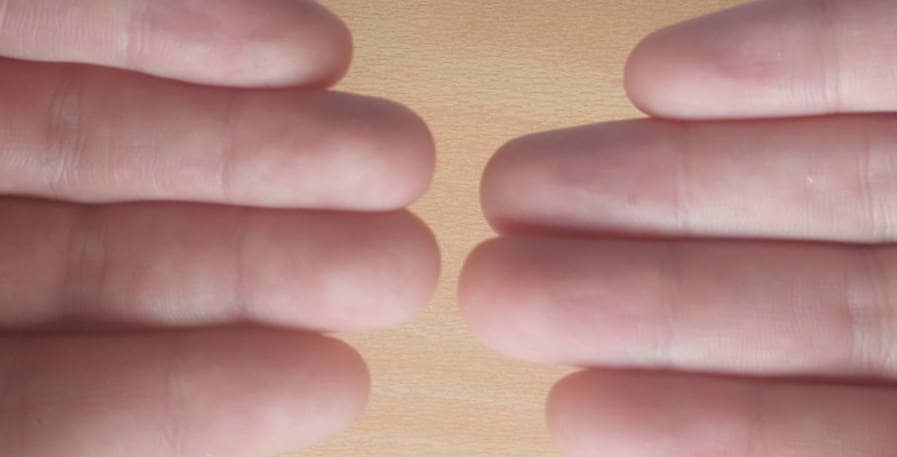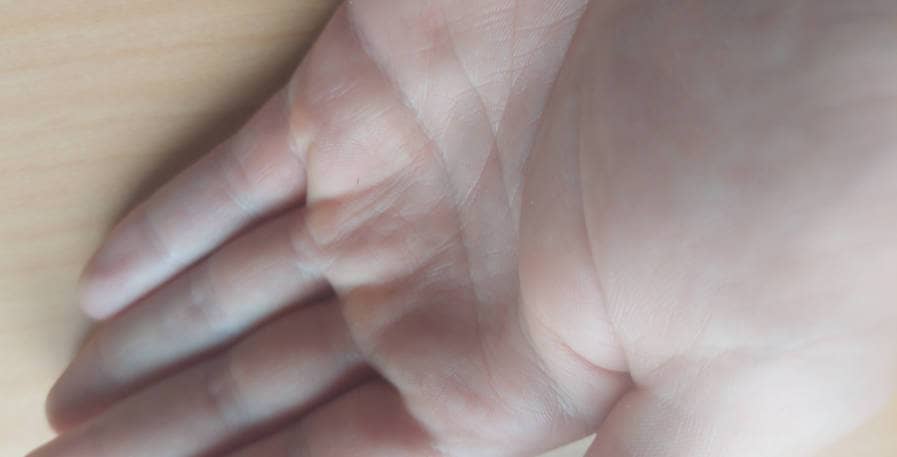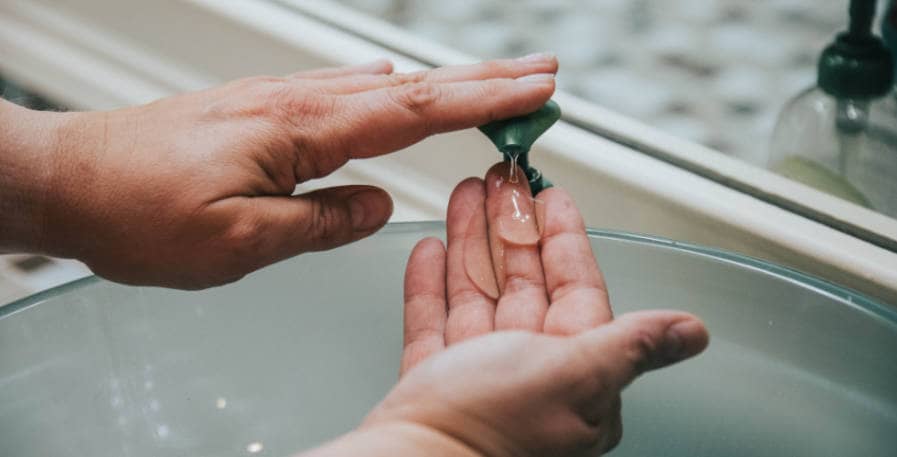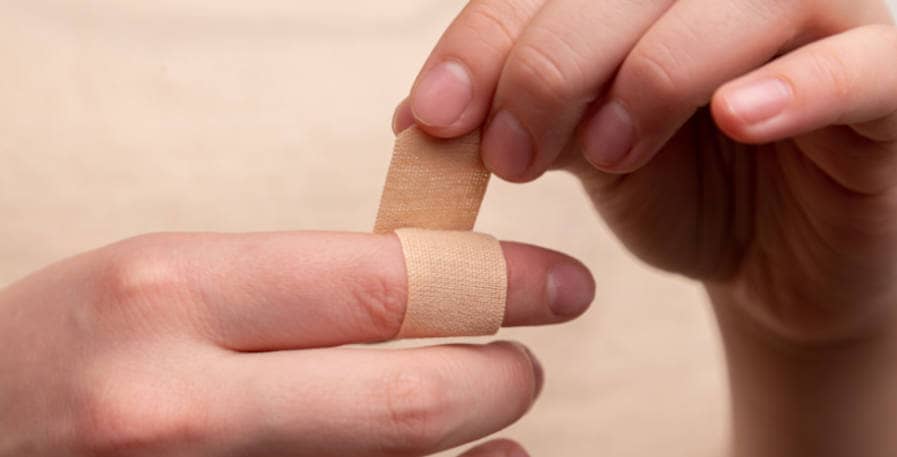This post contains affiliate links
Most bass guitarists tend to develop blisters at some point. Usually, this happens sooner rather than later.
I developed blisters in a matter of days when I first started out with the bass. Not surprising, considering I tried to jump right into playing fast melodic death metal grooves. It didn`t go very well, and my fingers were in quite a bit of pain afterward.
However, it`s also common for bassists who start out more methodically than I did to develop blisters. Albeit not as fast.
Because bass blisters are such a common pain for us, I thus decided to write this guide.
I`ll show you why blisters are common, and why they can actually be a good thing. Then, we`ll take a look at how long blisters usually last, and what to do once you have developed them. Lastly, while I don`t recommend trying to avoid developing blisters, I`ll show you how to prevent them if you want to do so.
Is it normal to get blisters from playing bass?
It is common to develop blisters on your fingers from playing bass. As your fingers are hit against thick metal strings when playing the bass guitar, they will need to become resilient in order to withstand this friction. Thus, while possible to avoid, the majority of bassists develop blisters.
I`ve heard some musicians claim that you should not get blisters from most string instruments if you have proper technique.
While it`s possible to never get blisters from playing bass, this requires a very soft and controlled touch when plucking and fretting strings. As bassists tend to develop blisters in their beginning stages, it can thus be hard to have this level of control over the instrument when just starting out.
Playing to never develop blisters also puts limitations on your tone. As you cannot pluck strings too hard with your fingers, an aggressive Geddy Lee type tone will be practically impossible to attain without developing blisters.
You will also be limited in how dynamic you can make your playing. Thus, making certain notes more pronounced will be significantly harder, which can make it harder to add personality to your playing.
Lastly, the bass is a low-end instrument, which means it has thick strings. The thicker the string the more demanding it will be on your fingers, which in turn increases the chance of developing blisters.
Given that guitarists commonly get blisters, it comes as no surprise that they are thus even more common among bass players.
Why bass blisters are a good sign
While blisters can be painful, they are also the first step in developing calluses as a bass player. Calluses are hardened spots of skin and are formed from repeatedly being exposed to friction.
I consider calluses to be a good thing for bassists for several reasons. First of all, as the skin on your fingers hardens it becomes less painful to play. Second, unless you take long breaks from playing, you are highly unlikely to develop blisters again once calluses have formed.
Most experienced bass players I know have calluses that formed as a result of them initially developing blisters from playing.
I have played bass for 15 years now, mainly using my index and middle finger to pluck strings. Thus, I had my initial blisters turn into calluses a long time ago.
These calluses have become increasingly less noticeable over the years. While hard to spot, they are however still there. My fingertips are hard because of them, and they faintly appear as lighter and more transparent spots of skin.

Let`s compare this to the calluses where my fingers and palm meet. I have gotten these from lifting weights, which I do significantly rarer than playing bass. I`ve also only been doing it for 1 year, as opposed to 15:

Notice how pronounced they are compared to the calluses on my fingertips. In time, and with regular exposure to friction, these calluses have the potential of becoming less pronounced while remaining hardened.
Thus, the more you play, the more robust your fingers will become for handling the thick metal strings of the bass guitar. With that, blisters are merely the first sign that your fingers have started to adjust to your instrument.
Should you keep playing bass with blisters?
In general, it is a best practice to limit the time you spend playing bass when you develop blisters. This is because playing can feel painful and unpleasant. Playing bass also increases the risk of the blisters bursting, which will prolong the time it takes for them to form into calluses and increase the chance of infections.
Here`s the good news though, you can still improve as a bass player even with blisters on your fingers.
If you have only developed blisters on your left or your right-hand fingers, you can still use the other hand to practice. This can be great for practicing scales with your fretting hand, or for keeping strings muted with your plucking hand.
Another great alternative is to focus on the theoretical aspects of playing bass. Reading sheet music as a bassist is not a necessity to learn the instrument, but it is a helpful skill. If that`s a bit too much, memorizing scale patterns or learning new ones is also a great use of your time.
If you do decide to play the bass with blisters, I recommend sticking to simple patterns and avoiding intermediate techniques. Soloing or jamming on your bass can be extremely demanding on your fingers, and will increase the chance of feeling pain and having the blisters burst.
How long do bass blisters last?
It tends to take blisters 3 to 7 days to heal on their own. However, they tend to diminish greatly in size after just a couple of days of having formed. Thus, you can generally get back to playing the bass without the risk of the blisters bursting after 2-3 days.
While blisters can take up to a week to heal, they become significantly less pronounced during this time. This is good news for us bassists, as it usually won`t take long before we can get back to playing.
How long you should wait before picking up the bass again depends on whether the blisters are bloated enough that they will burst from playing. It also depends on whether they are making it painful for you to fret or pluck strings.
Thus, if you want to get back to playing as soon as possible, evaluate the condition of the blisters 2 days after they have formed. If they are still noticeably bloated, I recommend waiting one more day and examining them again before attempting to play the bass.
You can attempt to carefully play the bass after a couple of days if the blisters are not too bloated. If it feels painful, I again advise you to wait another day and try again.

How do you treat blisters from playing bass?
Once you develop blisters from playing bass, there are some steps you can take to make the healing process efficient, painless, and sanitary.
While it can be tempting to drain them immediately, it`s generally preferable to focus on them healing instead. This will reduce the chance of the blisters getting infected, and will allow them to develop into calluses faster.
Here`s what I would do now if I were to develop new blisters from playing bass:
Keep the blisters clean
Blisters will heal on their own in a manner of days. However, if a blister gets infected, it could lead to a skin infection. In severe cases, it can also lead to sepsis, which is a potentially fatal bloodstream infection.
For this reason, it`s a best practice to keep blisters clean and sanitized. You can do this by washing them in running water at about 37°C (99°F) and using soap.
An Antibiotic ointment can also be used to treat and soothe the blisters and protect them from infections. You can get these without a prescription at most pharmacies. Antibiotic ointments are also available on Amazon.
Cover it with a bandaid
To avoid the blisters getting infected or bursting, it is also advisable to keep them protected. The best and easiest way to do this is to simply wrap a bandaid around it.
I have heard about some bassists using duct tape for this purpose. While I have heard of this working fine, I do advise against it. Tape is not kept in sanitary packaging the same way bandaids are, and thus it does not provide the same level of protection against infections.
How do you prevent blisters when playing Bass?
While getting blisters are an expected part of playing bass, there are some steps you can take to prevent them from forming if you wish to go that route.
One of these is to play with a softer technique and a more gentle touch, as discussed above. A more effective way though is to play the bass with gloves.
Gloves add a layer of protection between your fingers and the metal strings. Thus, they can greatly decrease the chance of blisters ever forming on your hands if you stick to wearing them while playing.
They also have several other benefits, such as preventing cold hands, making strings easier to mute, and preventing string rust from hand sweat.
Any soft and thin pair of gloves that don`t hamper your playing will do the trick. If you don`t have gloves of this kind, I recommend this soft and flexible set off Amazon. I say this because these gloves are thin enough that they won`t noticeably impact your playing, while still protecting your hands sufficiently.
Conclusion
While blisters are very common for double bass players, you can also expect to develop them on the electric bass as well.
Blisters can be drained safely, though I would advise against this if you intend to continue playing the bass. Draining them does not mean that you won`t develop blisters again, and will only prolong the time it takes for you to develop calluses.
Trying to prevent blisters can put limitations on your technique and your tone. You can however slow down or prevent the forming of blisters by playing the bass softer or with gloves.
It`s preferable to focus on other areas of improving at the bass than playing when you develop blisters. In general, you can get back to playing in 2-3 days without the risk of them bursting or causing pain.
To treat blisters, wash them under running water with soap. Cover blisters with a bandaid. This will reduce the chance of skin or bloodstream infections. While using duct tape to cover blisters is common advice among bassists, I advise against it for sanitary reasons.

